Foot drop patient has a difficulty to lifting the front part of their foot due to weakness or paralysis of the tibialis anterior muscle. Physiotherapy for foot drop helps to strengthen the muscles.
When the foot drops patient walks, the foot slaps down on the floor. This looks like patient might be dragging their foot to the ground. Foot drop is not a disease. It is a symptom of muscular, neurological and anatomical disorder.
The peroneal nerve is a nerve that carries signals from your brain and to contract the muscles that lift the front part of your foot. This nerve wraps from the back side of your knee, to the front of your shin, where it sits really close to the surface which makes damage really easy.
Causes of Foot Drop
There are three main causes of foot drop.
- Nerve injury
- Muscle disorders
- Spinal cord disorders
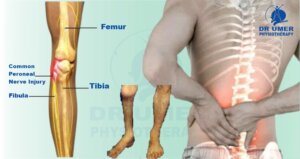
Nerve injury
Damage or compression of the peroneal nerve is the most common cause of foot drop. Damage of nerve can be caused by sports injury, hip or knee replacement surgery, low back injury (like a slipped disc or a pinched nerve) and leg cast childbirth.
Muscle disorder
Muscle disorders are conditions that cause muscles to gradually weaken. This disorder may include muscular dystrophy, Charcot-Marie-Tooth disease or polio.
Spinal cord disorders
Foot drop occurs is from spinal cord disorders, which are disorders that affect the brain and spinal cord directly. These conditions may include stroke, multiple sclerosis, amyotrophic lateral sclerosis and cerebral palsy.
Physiotherapy for Foot Drop
Physical-Therapy is the best way to treat foot drop. Physiotherapy is beneficial in all these three causes. Physical Therapist helps you to strengthen the foot, ankle and lower leg muscles. Stretching and range of motion exercises will also help prevent stiffness from developing in the heel and the foot. Physiotherapist also suggest you, how to walk and how to do daily routine activities. Splint and braces also helpful in foot drop by advising a physical therapist. Physiotherapist is capable to diagnose the foot drop. Foot drop can diagnose with these easy tests.
Drag or Slap
The most common symptoms of foot drop a dragging foot. Have the patient walk 10 to 15 steps for checking the foot drop.
Heel Walk
Walk in heels for approximately 10 to 15 feet. If you cannot walk on the heels. Hold toes off the ground standing on the heels look for affected foot. Hold a wall for safety purpose.
Manual Muscle
Sit in a chair, stretched your affected legs, trying to lift your toes and foot. Hold it there for checking the muscles strength.
Up and Down
If the foot drop not diagnosed in above three steps then go for up and down. If the patient had poor balance then hold a wall and start with slowly up and down in stair. When patient feels comfortable then increase the speed of stepping up and down.
Exercises of Foot Drop
Ball Lift
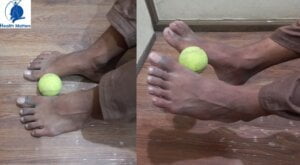
Sit in a chair with your flat feet on the floor. Place a ball on the floor. Grab the ball using both of your feet. Extend your legs to lift it. Hold for three seconds. Return back to starting position. Repeat 10 times.
Modified Toe Raises
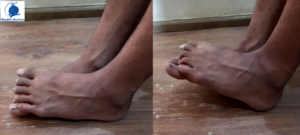
Sit in a chair with your feet on the ground. Slide your other foot underneath the affected one and use the lower foot to lift the front part of your affected foot while keeping both heels on the ground. Repeat 10 times.
Towel Stretch
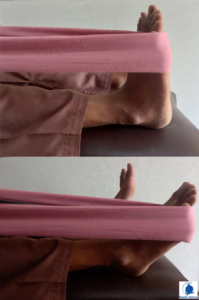
Sit on the floor with your legs extended in front of you, loop a towel around the arch of your foot. Pull the towel towards your body. Feel a good stretch. Hold for 30 seconds and release. Repeat 5 times.
Ankle Eversion
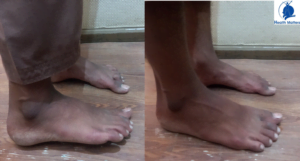
Stand with your injured foot slightly in front of your other foot. Rotate your foot to up the outer edge toward the ceiling. Hold for three seconds and relax. Do this exercise for twisting motion. Repeat 10 times.
Toe to Heel Rocks
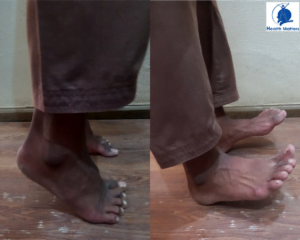
Rock your weight forward to up onto your toes. Hold the position for 3 seconds. Rock your weight backward and up your toes off the ground. Hold for 5 seconds. Repeat 10 times.
Ankle Rotations
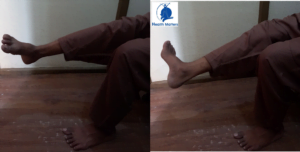
Sit in a chair with your back supported. Raise one leg in the air. Slowly rotate your foot as far inward. Hold the position for three seconds. Next slowly rotate your foot outward. Repeat 10 times for each leg.
Electrical Therapy
Click the link to know about electrical therapy.


